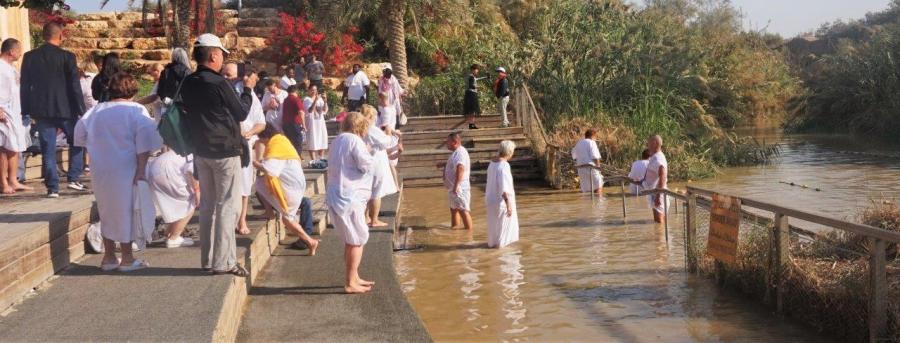For more than 40 years, it was almost impossible and dangerous to visit the original baptismal site of Jesus due to the presence of landmines, planted by the Israeli Army after the Six Day War in 1967 to prevent infiltration from Jordan.
Fully re-opened in 2019, I had the privilege to stand on the banks of the Jordan River where Jesus was baptised by John the Baptist, on my visit in December.

Located in the wilderness of the Jordan River Valley, north of the Dead Sea and east of Jericho, Qasr Al-Yahud is also believed to be where
- the Children of Israel crossed into the Promised Land (Israel) after leaving Egypt
- Elijah ascended into heaven in a “chariot of fire”
- Elisha performed miracles
Getting there, I could not help but notice the barb wire surrounding the closed military zone as we drove through the barren desert landscape.


Though it was early, the place was a hive of activity, with numerous groups in various stages of preparation for the immersion ceremony.
Some pilgrims were busy putting on the baptismal robe, while others had a quiet moment in prayer as they waited in line at the deck for their turn to step into the water.


The Jordan River is considered the third most holy site in the Christian world after the Church of the Nativity in Bethlehem and the Church of the Holy Sepulchre in Jerusalem. It is the site of the most important event of Jesus’ life – his baptism and the beginning of his ministry.
For pilgrims, to be baptised at the same spot where Jesus was baptised is an enhanced experience of a uniquely spiritual moment. This holds true for second baptisms or re-dedications too.
Don’t be surprise if you see visitors bottling a small quantity of water to bring home as a keepsake.
Qasr Al-Yahud Newly restored and refurbished with wheelchair access and improved parking, on-site facilities include prayer chapels, benches for worshipers, changing rooms, showers, toilets and visitor’s centre. This beautiful site at the Israeli-Jordanian border is surrounded by new and ancient monasteries.

Entry Fee : None Opening Hours Summer hours: Sunday–Thursday and Saturday: 08:00 - 16:00 Friday and holiday eves: 08:00 - 15:00 Winter hours: Sunday–Thursday and Saturday: 08:00 - 15:00 Friday and holiday eves: 08:00 - 14:00 Last entry to the site: one hour before site closes
Mines & Booby Traps
After the Six-Day War in June 1967 between Israel and the Arab states of Egypt, Syria and Jordan, both sides of the river were declared closed military sites, riddled with thousands of land mines.

Land of the Monastries
Seven churches along with chapels and monasteries, each belonging to a different denomination of Christianity, had been abandoned as some are booby-trapped.
Between 1967 – 1994, cut off and with no safe access for pilgrims and tourists, Yardenit, next to the Sea of Galilee, was started as an alternative baptismal site.
From 2011, Qasr Al-Yahud was partially re-opened – as an enclave within a closed military zone, under the management of the Israel Nature and Parks Authority. Safe access was limited to a narrow path from the Greek Orthodox St. John the Baptist Monastery to the Jordan River.
Attempts to remove the mines over the decades had been painstakingly slow. Funded by Israel and private donors, the de-mining project started in earnest in March 2018. The area was finally given the all clear after two years.

Church plots and public areas were finally swept and cleared of all explosive devices.
The intention is to restore the site and return the monasteries to their churches so that Christian pilgrims and other people of faith from around the world can come and visit once again.
The Times of Israel
Jordan-Holyland-Egypt
Full Itinerary 29 Nov – 10 Dec 2019
- 29 Nov
- 30 Nov – Lost city of Petra, Jordan
- 1 Dec
- 2 Dec
- 3 Dec
- 4 Dec
- 5 Dec
- 6 Dec – Route 90 – longest road in Israel
- 7 Dec – Mt Sinai by moonlight!
- 8 Dec – Giant Pyramids of Giza


